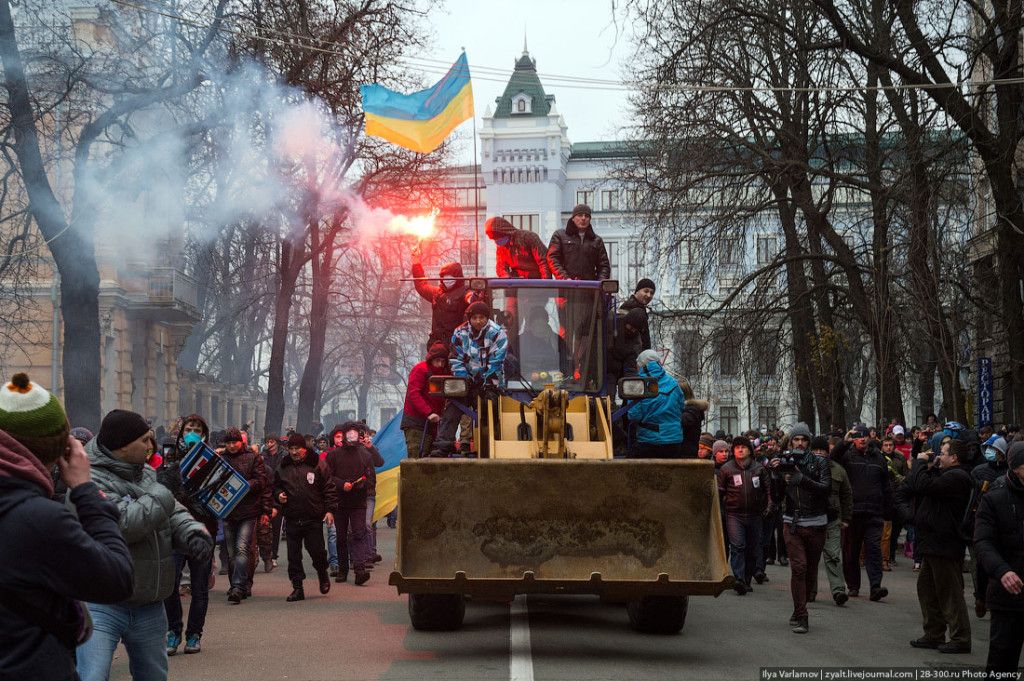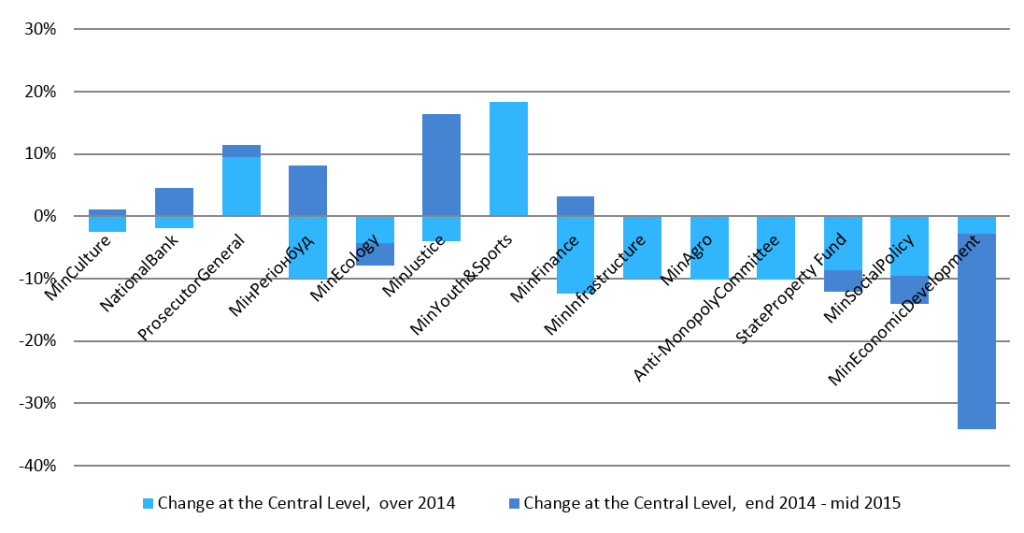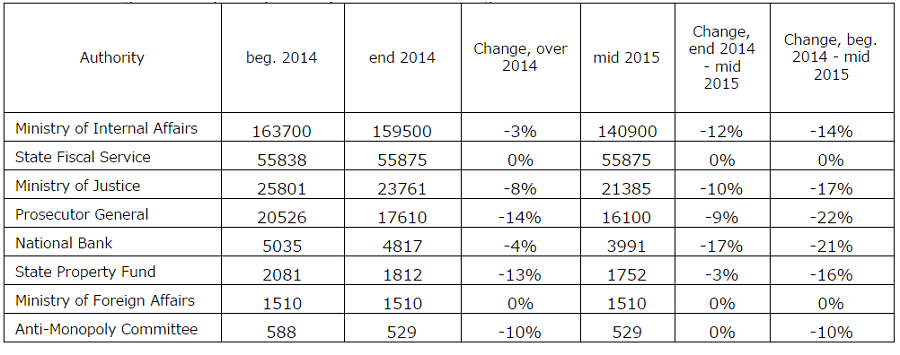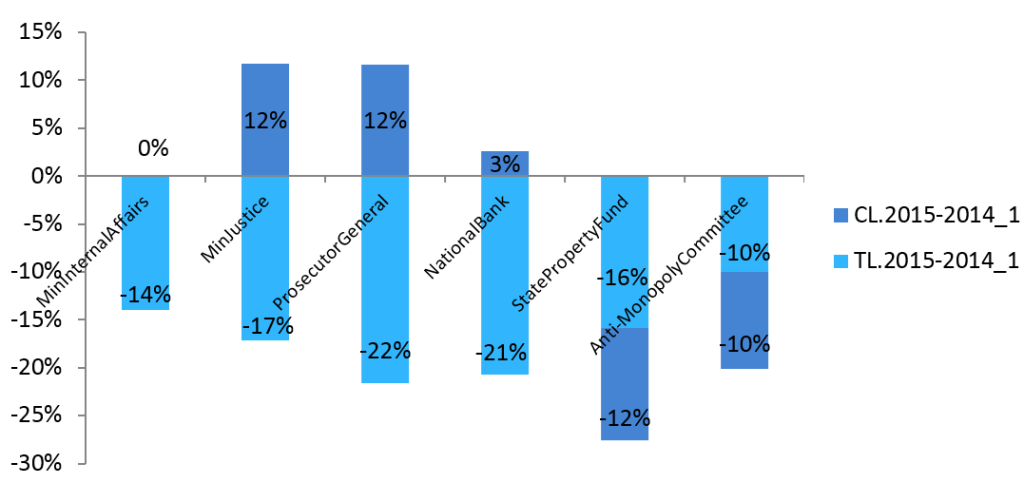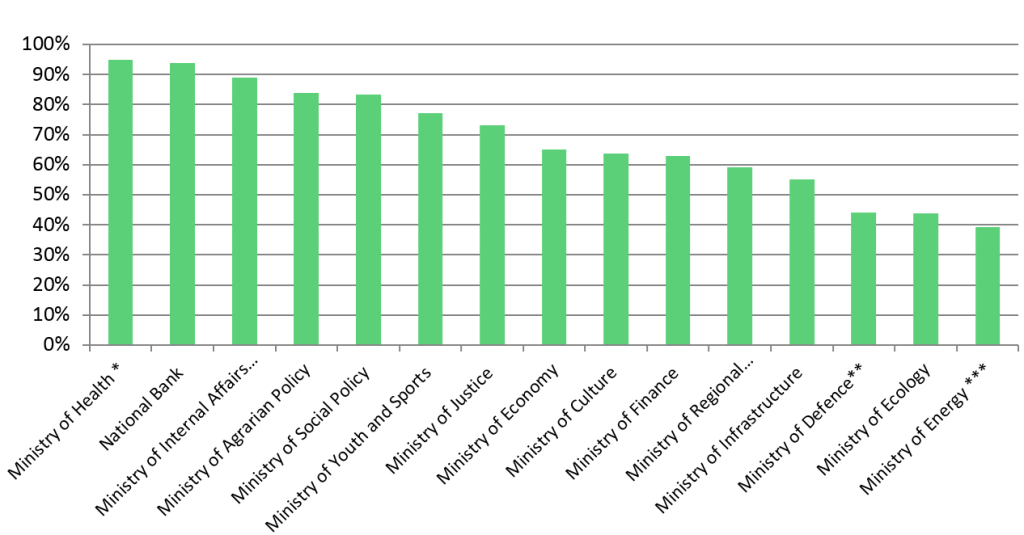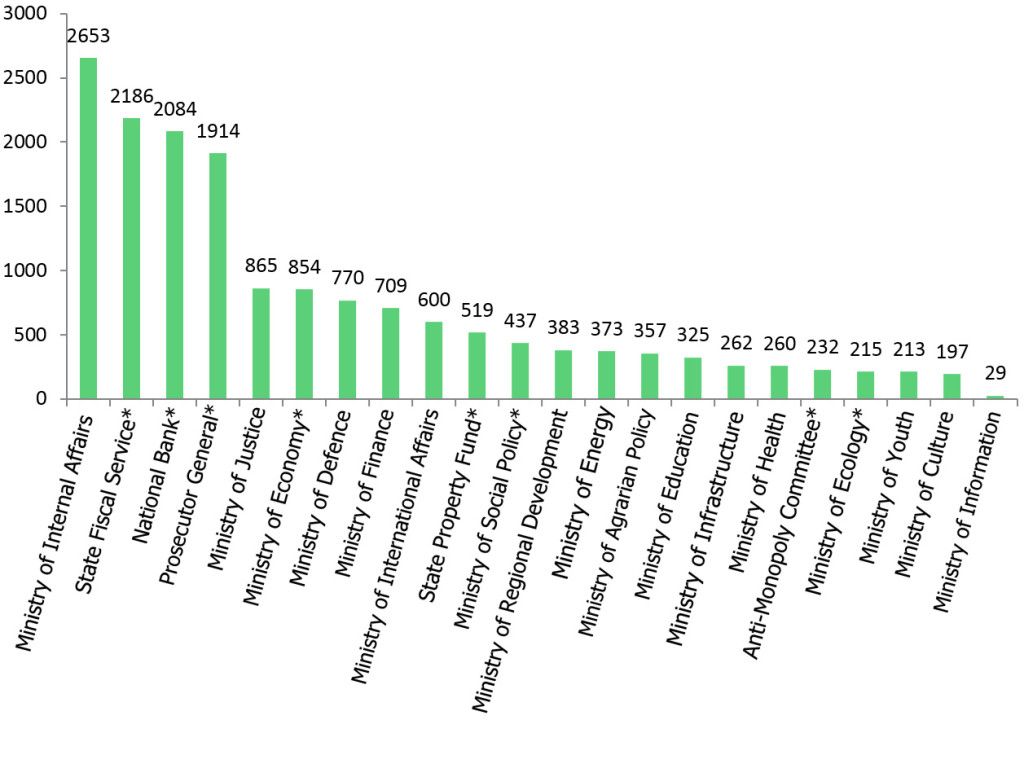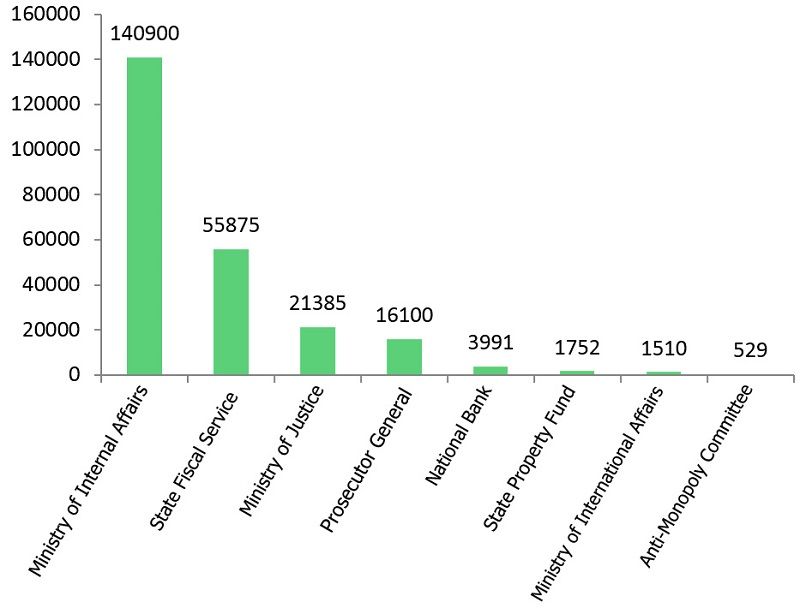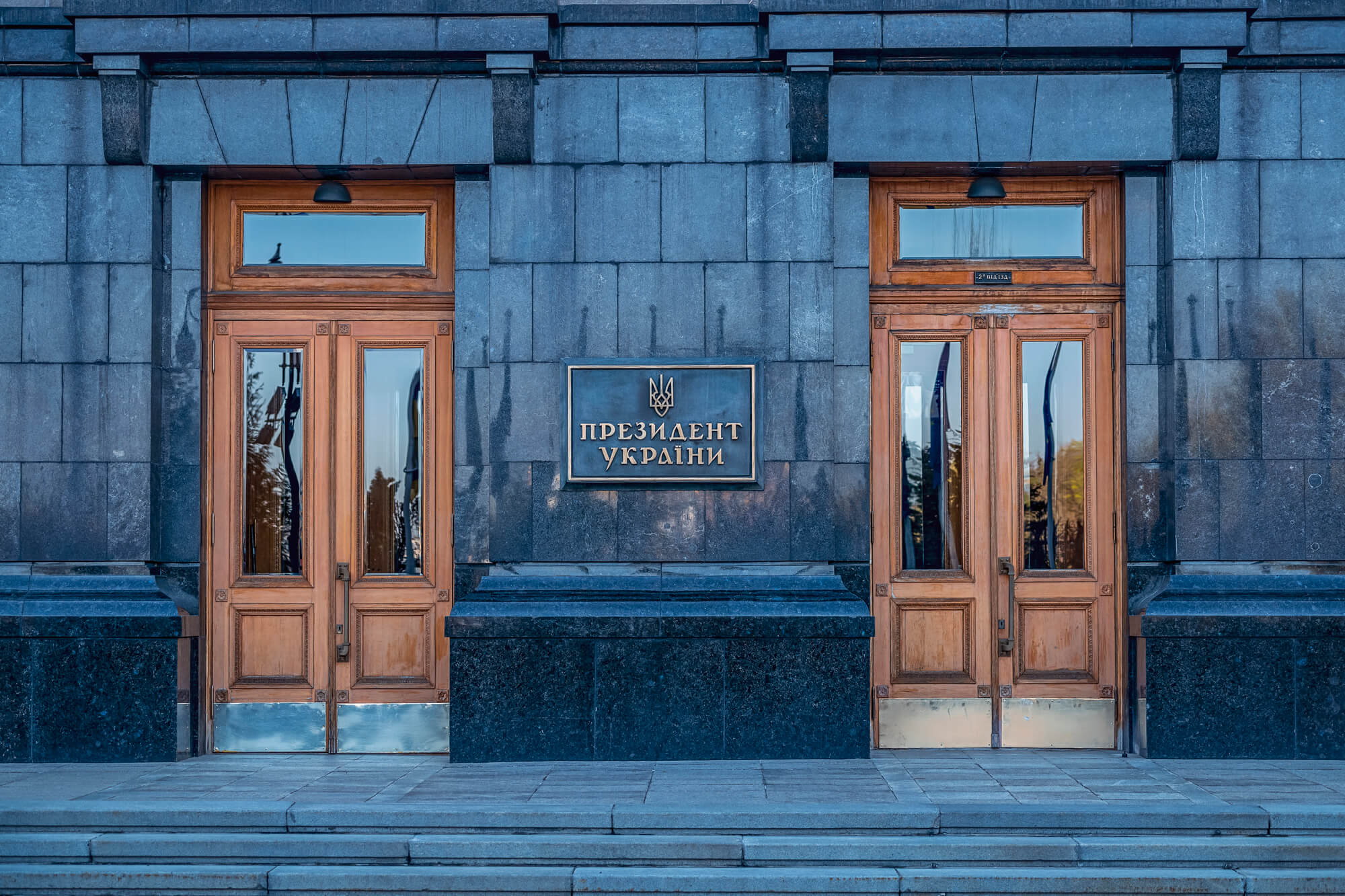Authors: Tymofiy Mylovanov (U.Pittsburgh, VoxUkraine), Yegor Grygorenko, Vadym Bizyaev (KSE), Natalia Shapoval (KSE, VoxUkraine)
The authors don’t work for, consult for, own shares in or receive funding from any company or organization that would benefit from this article, and has no relevant affiliations
The president, the prime minister, some of the high ranked members of the government, some of the governors in the regions, and many of the MPs in the parliament had belonged to the ruling elite long before the revolution of 2013-2014. But there are many new faces in among the new leaders of the country: 65% of people in the new parliament have not served there under the previous president. The reforms conducted in Ukraine under the guidance of the semi-new elites and international community can break the old connections and open the way for the new leaders, not captured by the ghosts from the past. This article provides an overview of staff changes in the executive branch of the national government. We look at two statistics: the downsizing rate (net % of staff laid off) and the renewal rate (% of staff who has not served under the previous government).
The 21st century gave rise to a new type of leaderless revolutions [1]. The Arab Spring and Ukraine are case in point. The major driving forces of the resistance to the regime were people who didn’t have political affiliations. There was no single leader. There was no clear ideological or political agenda. Most of the participants did not have a purpose to seize the power in the country. Instead, the united cause was dissatisfaction with the existing regime. Yet, there was no clear strategy about what to do after (and if) the regime is gone.
The revolution in Ukraine succeeded in removing the president and some of his close allies. They are now in exile. Ukraine has elected the new president and the new parliament. The new coalition government took the office in the end of the last year. There are many new faces in among the new leaders of the country: 65% of people in the new parliament have not served there under the previous president.
There are also many people who have built successful careers within the previous regimes. The leaderless revolution in Ukraine didn`t bring fundamental change of de-facto country leadership. The president, the prime minister, some of the high ranked members of the government, some of the governors in the regions, and many of the MPs in the parliament had belonged to the ruling elite long before the revolution of 2013-2014. These people may continue to be influenced by the existing corrupt networks. Some of them might even help to recruit and subvert new forces in the government and the parliament. The reforms conducted in Ukraine under the guidance of the semi-new elites and international community can break the old connections and open the way for the new leaders, not captured by the ghosts from the past. But will they?
This article provides an overview of staff changes in the executive branch of the national government. We look at two statistics: the downsizing rate (net % of staff laid off) and the renewal rate (% of staff who has not served under the previous government).
Based on self-reported data, we find that
- The Central Apparatus of the Central Executive Authorities has been downsized, but the change is minor. Average reduction for the period from the beginning of 2014 till mid 2015 is 5%.
- Some Authorities have substantively reduced their regional units. The leaders are law enforcement authorities and the central bank. The Ministry of Internal Affairs has cut 14% of local people, the Ministry of Justice and Prosecutor General` Offices reduced their sizes for 22%, the central bank – 21%.
- The renewal rate among the top levels of the government (ministers, deputies, heads of departments) is about 80%, benchmarked to the beginning of 2014. The management of the State Fiscal Service and the Prosecutor General Office are renewed at 91%.
- The renewal rate drops dramatically for lower levels of the hierarchy in the government.
The Experiment
VoxUkraine has collected data about the total number of employees and names of the personnel at the first three levels from the following central executive authorities: the National Bank of Ukraine, General Prosecutor Office, State Property Fund, Anti-Monopoly Committee, State Fiscal Service of Ukraine, National Electricity Regulatory Commission of Ukraine (NERCU), SE Naftogaz, and all the Ministries.
National Electricity Regulatory Commission of Ukraine and Naftogaz have refused to submit the data in response to VoxUkraine’s request, while all other agencies have responded.
In some cases the agencies offered incomplete data.
The data has been collected for 3 points of time:
- beginning of 2014 – when Viktor Yanykovych was still in power,
- end of 2014 – the period when the Temporary Government was in the office,
- mid 2015 [2] – when the new Cabinet took the office and formed their teams.
Quantitative changes
The Central Apparatus of the Central Executive Authorities has been downsized, but the rate is small. Average reduction for the period from the beginning of 2014 till mid 2015 is 5%. At the ministry level, the picture is more nuanced and heterogeneous. Some authorities have cut the number of employees: Ministry of Economic Development and Trade – 34%, Ministry of Social Policy – 15%, State Property Fund – 13%, Anti-Monopoly Committee, Ministry of Infrastructure, Ministry of Finance, Ministry of Agrarian Policy – 11%, Ministry of Ecology – 8%, Ministry of Regional Development and Trade – 3%, Ministry of Culture – 2%.
Others have increased the number of employees of their central offices from the beginning of 2014 till mid 2015: f.e. NBU increased for 3%, Ministry of Justice for 12%, Prosecutor General Office for 11%, and Ministry of Youth and Sports for 15%.
There are several caveats: Some agencies reported the actual number of employees, while others reported the so-called “staffing number” (штатна чисельність), which is basically a number of positions, but not the number of employees. The maximum allowed quantity of the employees (and, hence, positions) of the central executive authority is defined by the Law, but the agencies are allowed to have less than the maximum number of positions. Some share of the positions is frequently unoccupied. Therefore, “reduction” can happen nominally, by cutting empty positions. As we are using self-reported data in some cases we can be dealing with “positions”, while in other – with “employees”. At the same time, the labour code restricts conditions for replacing employees. Hence, the growth in numbers of employees of the central offices can reflect the arrival of new ministers and their teams. Basically, if it is difficult or impossible to fire the existing old guard, a minister might choose to create new departments and positions to hire his team.
Table 1. Changes in the quantity of the personnel in the Central Apparatus of the Executive Authorities
| Authority | Quantity, beg. 2014 |
Quantity, end 2014 |
Change, over 2014 | Quantity, mid 2015 |
Change, end 2014 – mid 2015 | Change, beg. 2014 – mid 2015 |
| Ministry of Youth and Sports | 180 | 213 | 18% | 213 | 0% | 18% |
| Ministry of Justice | 774 | 743 | -4% | 865 | 16% | 12% |
| Prosecutor General Office | 1714 | 1876 | 9% | 1914 | 2% | 12% |
| National Bank* | 2031 | 1993 | -2% | 2084 | 5% | 3% |
| Ministry of Culture* | 200 | 195 | -3% | 197 | 1% | -2% |
| Ministry of Regional Development | 393 | 354 | -10% | 383 | 8% | -3% |
| Ministry of Ecology* | 233 | 223 | -4% | 215 | -4% | -8% |
| Ministry of Finance* | 784 | 687 | -12% | 709 | 3% | -10% |
| Ministry of Infrastructure | 291 | 262 | -10% | 262 | 0% | -10% |
| Ministry of Agrarian Policy | 397 | 357 | -10% | 357 | 0% | -10% |
| Anti-Monopoly Committee | 258 | 232 | -10% | 232 | 0% | -10% |
| State Property Fund* | 588 | 537 | -9% | 519 | -3% | -12% |
| Ministry of Social Policy* | 506 | 458 | -9% | 437 | -5% | -14% |
| Ministry of Economic Development | 1279 | 1243 | -3% | 854 | -31% | -33% |
| Ministry of Internal Affairs | 2653 | 2653 | – | 2653 | – | – |
| State Fiscal Service | 2185 | 2186 | – | 2186 | – | – |
| Ministry of Defence | 770 | 770 | – | 770 | – | – |
| Ministry of Foreign Affairs | 600 | 600 | – | 600 | – | – |
| Ministry of Energy | 373 | 373 | – | 373 | – | – |
| Ministry of Education | 325 | 325 | – | 325 | – | – |
| Ministry of Health | 260 | 260 | – | 260 | – | – |
| Ministry of Informational Policy | – | – | – | 29 | – | – |
Note: Actual number – for Ministry of Social Policy, National Bank, Ministry of Ecology, Ministry of Finance, Ministry of Culture and Sate Property Fund. Staffing number for all the rest
Trends in 2014 and in 2015 had different directions. The Ministry of Economy, Ministry of Social Policy, Ministry of Ecology, have been gradually reducing their sizes – over 2014 and from the end of 2014 till April-May of 2015. The Ministry of Regional Development fired approximately the same number as they employed again. Ministry of Justice, Ministry of Culture, Ministry of Finance and NBU have increased the number of employees in 2015.
Figure 1. Percentage change in the number of employees in the Ministries/Agencies at the Central level. From the beginning of 2014 to the end of 2014, from the beginning of 2014 to the mid 2015
At the regional (or “territorial” as it is called in the legislation) level cuts were much more substantial. Law enforcement System is undergoing a transformation. The Ministry of Internal Affairs has cut 14% of regional employees – 23K, the Ministry of Justice and Prosecutor General` Offices reduced their sizes for 5.5K people – 22%. The NBU has also fired 1K of local people – 21%.
Table 2. Changes in the quantity of the personnel at the Regional Level of the Executive Authorities
Figure 2. Regional vs Central Level Reduction (Beginning 2014 – Mid 2015)
Qualitative changes
The first three levels of the government and the central bank – ministers and the Governor of the NBU, deputies, heads of the departments and independent units – are renewed by 50%, on average, if compared with the end of 2014 and by 80% if compared to the beginning of 2014. The State Fiscal Service and the Prosecutor General Office are renewed by 30% and 63% if compared to the end of 2014, and by 92% and 90% correspondingly – if compared to the beginning of 2014.
Figure 3. Share of new people at first 3 levels of management of the ministry (ministers, deputy ministers, heads of departments and independent units) Dec 2014 – May 2015
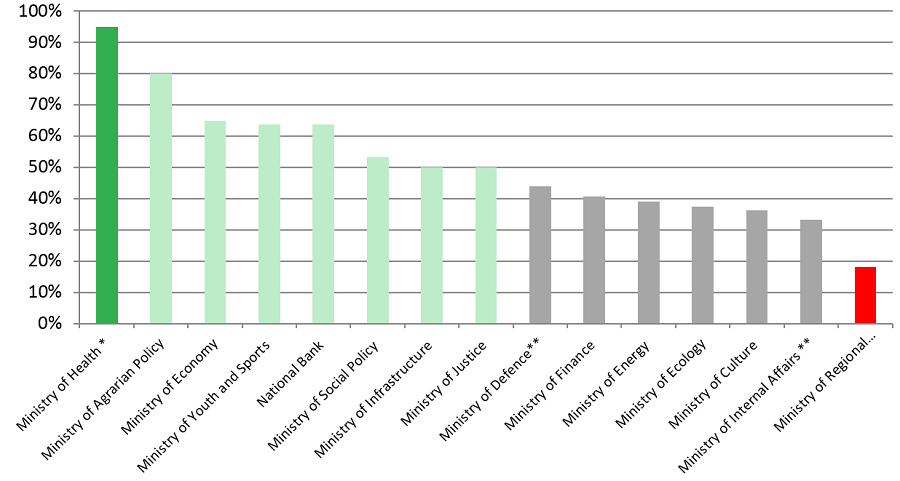
**only minister and his deputies for the Ministry of Internal Affairs
***2015 to end of 2014 in both cases – Dec 2014-May 2015 and Jan 2014 – May 2015
Sample: Ministry of Economic Development and Trade, Ministry of Agrarian Policy and Food, Ministry of Energy, Ministry of Infrastructure, Ministry of Culture, Ministry of Youth and Sports, Ministry of Education and Science , Ministry of Ecology, Ministry of Regional Development, Ministry of Social Policy, Ministry of Finance, Ministry of Justice. No: Ministry of Education and Science.
Figure 4. Share of new people at first 3 levels of management of the ministry (ministers, deputy ministers, heads of departments and independent units) Jan 2014 – May 2015
Share of new people is higher at the higher levels. Compared with the Yanukovych government, 100% of ministers and the head of the central bank are new, 84% of deputies are new (second level [3]) and 77% of the heads of the departments and independent units. For the fourth level – we have the data only for 3 ministries [4]. The rate is sufficiently lower. The estimate renewal rate for the 4th level is 56% assuming that the renewal rate is approximately the same in all the agencies.
Figure 5. Share of New People In The Ministries And Central Bank By The Level of Management
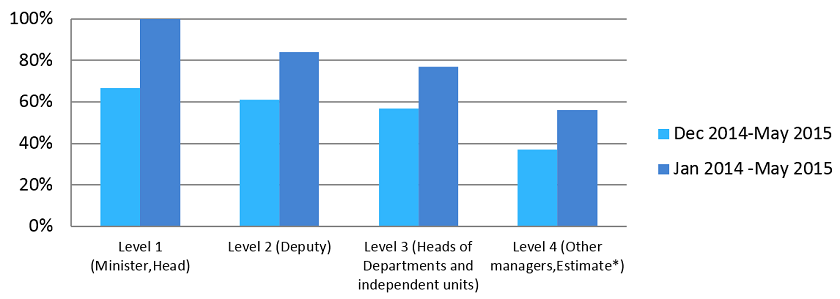
The State Fiscal Service and the Prosecutor General Office have 100% new Heads and Deputies compared with the beginning of 2014, the renewal rate at the 3rd level is 92% and 88% correspondingly.
To conclude
- The Central Apparatus of the Central Executive Authorities has been downsized, but the change is minor. Average reduction for the period from the beginning of 2014 till mid 2015 is 5%.
- Some authorities have considerably reduced the size of their regional units, in particular, law enforcement authorities and the central bank.
- The management of the government and the central bank are renewed by about 80% compared to the beginning of 2014. The management of the State Fiscal Service and the Prosecutor General Office are renewed by around 91%.
- The lower is the level of management in the agency – the lower is the renewal rate.
These results are encouraging; one hopes that changes through which Ukraine has been going have opened new channels that can assure a healthier turnover of the politicians and supply of new professionals.
Appendix.
Figure 6. The quantity of people that have been working in the Central Executive Authorities in May 2015, Central Level
Figure 7. The quantity of people that have been working in the Central Executive Authorities in May 2015, Regional Level
Note: Actual number – for Ministry of Social Policy, National Bank, Ministry of Ecology, Ministry of Finance, Ministry of Culture and Sate Property Fund. Staffing number for all the rest
Notes
[1] https://en.wikipedia.org/wiki/Leaderless_resistance#History
[2] In particular, we asked about January 2014, November 2014, and May 2015, but the data that we received described some other months, even though, close to the point we asked for
[3]Ukrainian legislation assumes 5 groups of civil servants and various sub-groups, but as soon as we interested in the management structure in particular, we are using own classification. Self reported data doesn`t allow to classify according to conventional Ukrainian classification. In the article we treat the first level as the one occupied by the ministers, head of the central bank, prosecutor general, etc; the second level – the deputies; the third level – the heads of the independent units of the agencies; the fourth level – the heads of the units and their deputies, as well as deputies of the heads of the managers of the third level
[4] Ministry of Economic Development and Trade, Ministry of Culture, Ministry of Ecology
If you would like to receive our weekly newsletter, please subscribe
